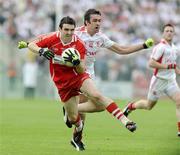You often hear a manager say to his defenders, “Don’t give your man an inch and get in his face”. This, to be fair, is an extremely tough task for the defender, especially if the forward they are marking is creative and generates a lot of movement because a forward like this can cause a lot of headaches for the guy marking them. 
While I too have been guilty of instructing defenders not to give their man an inch, what I am asking them to do is to be extremely close to their man and to be as sticky as possible. A forward hates this. Being five or 10 yards off your direct opponent is simply going against the instructions as issued by the manager and the defender will often be found out if this is how he marks. Tight marking should mean tight marking.
In defence of the defender, if the quality of ball being delivered is anyway good or at least to the forwards advantage and if it is delivered early then they really are going to be up against it in terms of winning primary possession. One thing that they can make sure happens, though, is when the forward takes possession of the ball that there is instant contact made and that he is being put under a certain amount of pressure. Any forward worth his salt will run riot if he is afforded any type of space when he gains possession, especially close to goal.
One way a defender can counteract this is by being brave and confident enough to mark from the front but always having a hand on his opponent. By marking from the front, this can cut out the options of high quality ball being played in but there is always a risk of a ball over the top. However, this can be covered off if the defender is doing his job and is within touching distance of the forward.
I’m not sure that defenders realise the impact that constantly having a hand on their opponent can have, particularly with the forwards’ mindset. Being a total nuisance when the ball is at the far end of the field can be so off-putting for an attacker. When I mention being a nuisance, I don’t condone mouthing off to your opponent or pulling and hauling of him. Resorting to these tactics can also have a negative impact on the defender’s performance. You can be a pest by giving your opponent a sly shoulder, standing in front of him, by having a constant hand on him – all of this within the rules of course.
Another way of finding out how mentally strong the forward is by eyeballing him until he turns away. A sure sign if ever that you are starting to get inside his head and his confidence is starting to dwindle. Will he want the next ball? Probably not. At this point if you can manage to get out in front and win the next ball, then this could well have the nail-in-the-coffin effect on the player and his performance.
Tight defenders don’t have to haul and drag their man to gain the upper hand. They can be physical and tough in the challenge and when they dispossess the attacker, smile at him as if to say, “I have you now”. This really annoys a forward and they start to seriously doubt themselves. They ask themselves questions like “How am I ever going to break this bollocks down?”
Defenders have got to realise that there are only a certain number of forwards playing the game that have a teak-tough mentality; a mentality that they can take any amount of nonsense thrown their way. The forwards with the weaker mentality will generally shirk the responsibility. Like any other player on the pitch, a defender must think and play smart and come up with ways of nullifying the threat of their opponent.
The methods mentioned above are based on my own experience of the type of defender that I generally found the going hard with. I particularly despised being marked by someone with blistering pace. The guy that would be prepared to take a chance and get to the ball first. Guys that played the game hard but played it fair. Some great examples of these type of players that I came face-to-face with are Ryan McCluskey, Kevin McGuckin, Enda McNulty, Andy Mallon, Tom O’Sullivan, Kieran Fitzgerald and, believe it or not, Ryan McMenamin. All top-class performers that played with physicality and certainly on the edge at times but players that as a forward I appreciated.



Very true resume.But skill was your main attribute and pride in wearing jersey.
“shake your opponent’s hand. When he turns make sure you see his number , 13, 14, 15 whatever. Don’t let that number out of your eyeline. Don’t let that number turn. You’re dead if you do”. Johnny Fordes All Ireland winning defender of Mayo 1950/51 advice to young backs.
The way todays forwards play in their own half of the field a lot of the time, it is harder for a defender to stick close to their man.
I agree Hugh. A lot of the time a forward forgets what his primary role is for the team and that is to score. You can’t do that from deep positions.
Love this Stevie, great advice. I always find with marking from in front that there are two issues: the second you watch the ball, your man is away behind you and you’ve lost him; and if you start watching him and not the ball, then before you know it a delivery has gone in to your man and you can’t see the ball to cut it out! Oftentimes if you have a forward that you know is faster than you and stronger all you can do is stick as close to him as possible and hope he makes a mistake/lay it off, while stopping him from turning…would you say that’s a fair enough assessment Stevie? Keep up the great work with the blog and site, a really great addition to the GAA media and insight into the game from the perspective of a top player.
Hi Conall. Thanks very much for your feedback. I understand your concerns. The defenders that are most effective by marking from the front are the guys that can do it side on so that they can keep an eye on their man and the play at the same time. There are always risks of course but you have to have enough confidence in your ability to do it this way.
Just wondering Steven do you think this same advice applies for those playing in the half back line? Or how should you mark your man from there in your opinion?
Tom, thanks for your query. The way our game has developed a different approach must be taken when playing in the half back line. It really depends on how the manager wants the half back to play because you can almost guarantee that the forward will roam. If it’s man for man then fitness plays a major part and its more a tagging job then and the half back has got to think of a way to put the forward on the back foot. Getting into the score zone is one way. if the forward is allowed to roam the defender must stay in line with him and once he crosses the 65 metre line, contact and hands on must be made at that point. The defender can certainly still get inside his head in this area so why not go for it.